
Chemistry
10th Edition
ISBN: 9781305957404
Author: Steven S. Zumdahl, Susan A. Zumdahl, Donald J. DeCoste
Publisher: Cengage Learning
expand_more
expand_more
format_list_bulleted
Concept explainers
Question
thumb_up100%
Questions 3 and 4 And the check the others

Transcribed Image Text:Homework for Unit 1
1. Determine the number of protons, neutrons and electrons for each of the
following nuclear symbols:
Nuclear
Symbol
Electrons
Neutrons
Protons
15
15
16
31p
18
15
33p
15
50
68
48
118Sn2+
16
16
18
3252.
6
22Na*
10
28Si4+
14
14
10
2. List all of the ipns in the problem above. SN,S. Ja. Si
3. What word describes the relationship between 31P and 33P?
4. Write the nuclear symbol that corresponds to each listed number of protons,
neutrons and electrons.
Nuclear
Symbol
Protons
Neutrons
Electrons
1
1
1
1
1
40
Ca
"Br
$Fe
20
20
18
35
46
36
26
29
24
14
14
14
Expert Solution
This question has been solved!
Explore an expertly crafted, step-by-step solution for a thorough understanding of key concepts.
This is a popular solution
Trending nowThis is a popular solution!
Step by stepSolved in 2 steps with 1 images

Knowledge Booster
Learn more about
Need a deep-dive on the concept behind this application? Look no further. Learn more about this topic, chemistry and related others by exploring similar questions and additional content below.Similar questions
- Gasoline is composed of a variety of different liquid hydrocarbons, which do not separate as time passes. Gasoline is an example of a: A) heterogeneous mixture B) Chemical compound C) Chemical element D) Solutionarrow_forwardHello, I need help on questions 4-7 if you can answer all of them? I gave you a data table and questions you can go ahead with. And the mass of NaCI is 12 grams.arrow_forward» Significant Figure Rules 01 >> 02 >> 03 >> 04 >> 05 >> All nonzero digits are significant. Zeros that appear between other nonzero digits are always significant. Zeros that appear in front of all of the nonzero digits are called left-end zeros. Left-end zeros are never significant. Zeros that appear after all nonzero digits are called right-end zeros. Right-end zeros in a number that locks a decimal point are not significant. ▬▬▬ 美銀銀時 ☐☐ Right-end zeros in a number with a decimal point are significant. This is true whether the zeros occur before or ofter the decimal point. 237 has three significant figures. 1.897 has four significant figures. 39,004 has five significant figures. 5.02 has three significant figures. 0.008 has one significant figure. 0.000416 has three significant figures. 140 has two significant figures. 75,210 has four significant figures. 620.0 has four significant figures. 19.000 has five significant figures. For multiplication and division problems, the answer…arrow_forward
- Question 2, B, C, D, And Earrow_forwardA. Characteristics of Elements, Compounds, and Mixtures 1. Complete the table: Color Luster Element Physical State iron sulfur mercury magnesiumarrow_forwardMcGraw Hil ALEKS CHEMISTRY-Gener... esc E ! 1 MEASUREMENT AND MATTER Adding or subtracting and multiplying or dividing measurements Explanation -1 gml1 Q A 1 A chemistry student must write down in her lab notebook the concentration of a solution of sodium thiosulfate. The concentration of a solution equals the mass of what's dissolved divided by the total volume of the solution. Here's how the student prepared the solution: • The label on the graduated cylinder says: empty weight: 1.500 g • She put some solid sodium thiosulfate into the graduated cylinder and weighed it. With the sodium thiosulfate added, the cylinder weighed 96.6 g. She added water to the graduated cylinder and dissolved the sodium thiosulfate completely. Then she read the total volume of the solution from the markings on the graduated cylinder. The total volume of the solution was 97.7 mL. What concentration should the student write down in her lab notebook? Be sure your answer has the correct number of significant…arrow_forward
arrow_back_ios
arrow_forward_ios
Recommended textbooks for you
 ChemistryChemistryISBN:9781305957404Author:Steven S. Zumdahl, Susan A. Zumdahl, Donald J. DeCostePublisher:Cengage Learning
ChemistryChemistryISBN:9781305957404Author:Steven S. Zumdahl, Susan A. Zumdahl, Donald J. DeCostePublisher:Cengage Learning ChemistryChemistryISBN:9781259911156Author:Raymond Chang Dr., Jason Overby ProfessorPublisher:McGraw-Hill Education
ChemistryChemistryISBN:9781259911156Author:Raymond Chang Dr., Jason Overby ProfessorPublisher:McGraw-Hill Education Principles of Instrumental AnalysisChemistryISBN:9781305577213Author:Douglas A. Skoog, F. James Holler, Stanley R. CrouchPublisher:Cengage Learning
Principles of Instrumental AnalysisChemistryISBN:9781305577213Author:Douglas A. Skoog, F. James Holler, Stanley R. CrouchPublisher:Cengage Learning Organic ChemistryChemistryISBN:9780078021558Author:Janice Gorzynski Smith Dr.Publisher:McGraw-Hill Education
Organic ChemistryChemistryISBN:9780078021558Author:Janice Gorzynski Smith Dr.Publisher:McGraw-Hill Education Chemistry: Principles and ReactionsChemistryISBN:9781305079373Author:William L. Masterton, Cecile N. HurleyPublisher:Cengage Learning
Chemistry: Principles and ReactionsChemistryISBN:9781305079373Author:William L. Masterton, Cecile N. HurleyPublisher:Cengage Learning Elementary Principles of Chemical Processes, Bind...ChemistryISBN:9781118431221Author:Richard M. Felder, Ronald W. Rousseau, Lisa G. BullardPublisher:WILEY
Elementary Principles of Chemical Processes, Bind...ChemistryISBN:9781118431221Author:Richard M. Felder, Ronald W. Rousseau, Lisa G. BullardPublisher:WILEY

Chemistry
Chemistry
ISBN:9781305957404
Author:Steven S. Zumdahl, Susan A. Zumdahl, Donald J. DeCoste
Publisher:Cengage Learning

Chemistry
Chemistry
ISBN:9781259911156
Author:Raymond Chang Dr., Jason Overby Professor
Publisher:McGraw-Hill Education

Principles of Instrumental Analysis
Chemistry
ISBN:9781305577213
Author:Douglas A. Skoog, F. James Holler, Stanley R. Crouch
Publisher:Cengage Learning

Organic Chemistry
Chemistry
ISBN:9780078021558
Author:Janice Gorzynski Smith Dr.
Publisher:McGraw-Hill Education

Chemistry: Principles and Reactions
Chemistry
ISBN:9781305079373
Author:William L. Masterton, Cecile N. Hurley
Publisher:Cengage Learning

Elementary Principles of Chemical Processes, Bind...
Chemistry
ISBN:9781118431221
Author:Richard M. Felder, Ronald W. Rousseau, Lisa G. Bullard
Publisher:WILEY